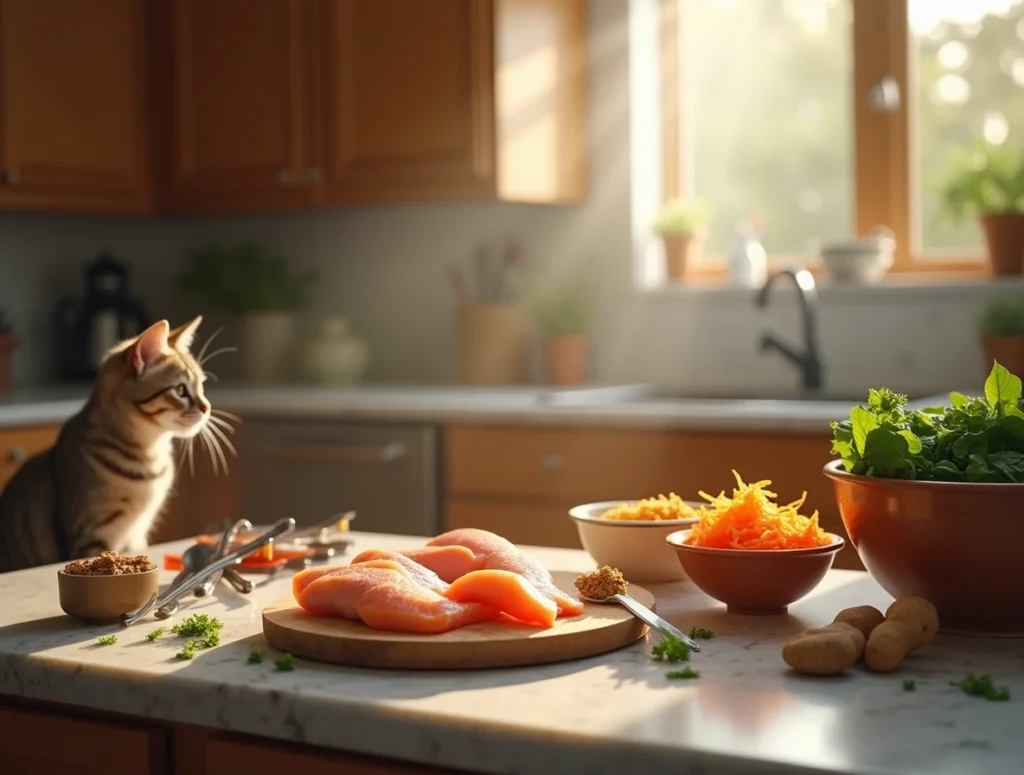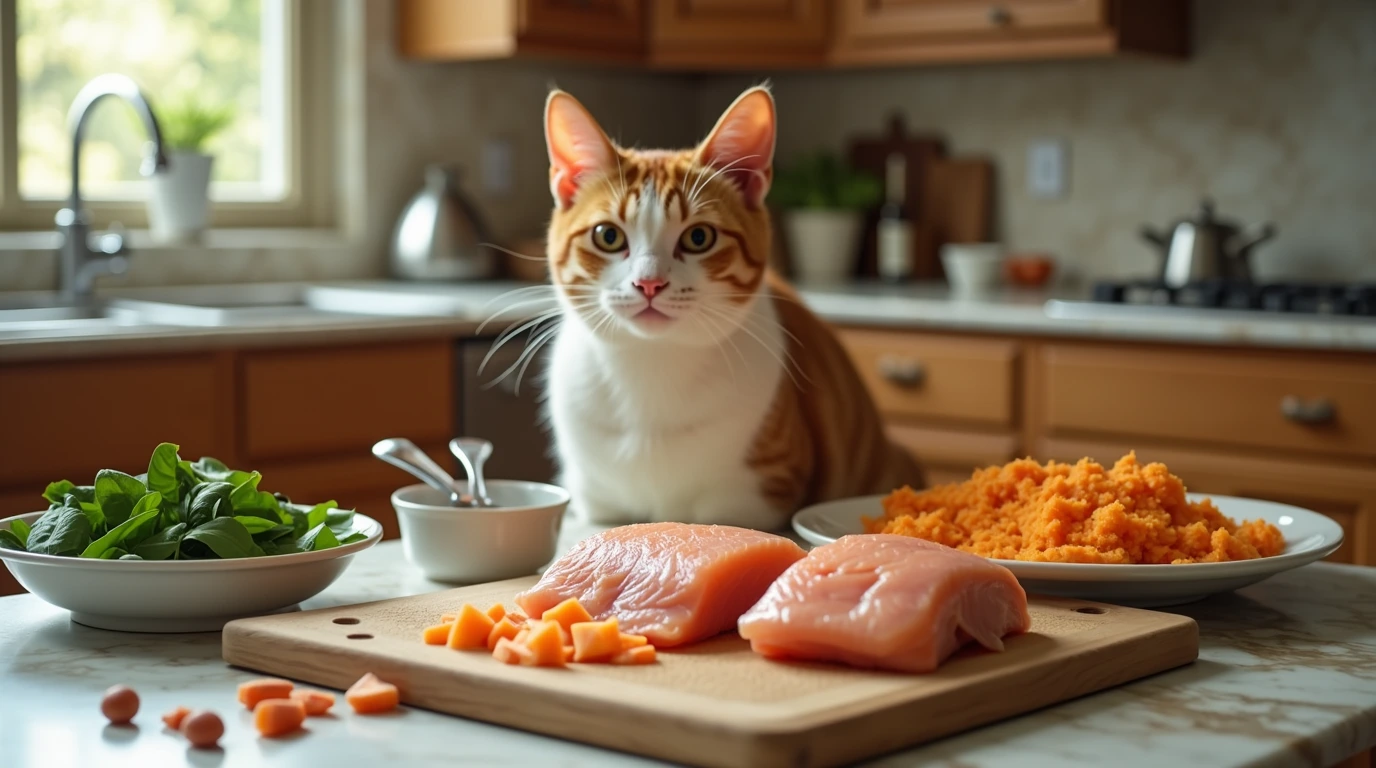Making Homemade Cat Food: Save Money and Make Your Cat Happy with Easy Home-Cooked Recipes
As a pet parent, you want the best for your cat, but with the ever-rising costs of commercial pet food, it can feel like a challenge to give your furry friend the nutrition they deserve without breaking the bank. If you’re tired of worrying about the hidden additives in store-bought food and want to take control of your cat’s diet, making homemade cat food might be the solution you’re looking for.
Not only can home-cooked meals be healthier and more satisfying for your cat, but it also offers a significant opportunity to save money in the long run. By preparing food from scratch, you have complete control over the ingredients, ensuring that every meal is fresh, nutritious, and tailored to your cat’s specific needs.
In this article, we’ll explore how to make homemade cat food, the benefits it brings for both your wallet and your pet’s health, and share simple recipes that will keep your cat happy and healthy.
Table of Contents
Why Make Homemade Cat Food? The Benefits for Your Cat and Your Wallet
Saving Money on Commercial Cat Food
If you’ve been feeding your cat high-quality commercial food, you’re likely aware of the price tag that comes with it. Premium cat foods can be quite costly, especially if you’re feeding your cat a special diet or require a brand that meets specific nutritional needs.
By making your own cat food, you can save a significant amount of money. You won’t have to worry about the mark-up costs that commercial brands impose. And by buying ingredients in bulk, you can prepare multiple meals at once, cutting down on the overall cost per meal.
Here are a few ways homemade cat food can help your wallet:
- Bulk Purchasing: One of the biggest advantages of making homemade cat food is the opportunity to save money through bulk purchasing. Ingredients like chicken, fish, and vegetables can be bought in larger quantities, which often come at a lower cost per unit. By buying in bulk, you can stock up on protein sources like chicken thighs, salmon, or tuna, and staple ingredients like sweet potatoes or carrots. These ingredients can be stored for longer periods, reducing your overall grocery expenses and minimizing waste. Additionally, buying large quantities of high-quality ingredients and preparing meals at home is more economical than constantly buying small cans or packages of commercial cat food.
- Avoid Overpaying for “Fancy” Brands: Many premium commercial cat food brands charge a significant markup for specialized formulas, claiming to offer the best nutrition or cater to specific health concerns. While these foods may sound appealing, the truth is that many of these so-called “fancy” brands are simply overpriced for what they offer. Often, you can recreate similar recipes at home for a fraction of the price. For example, a simple homemade meal made with chicken, pumpkin, and a taurine supplement provides essential nutrients at a much lower cost compared to specialized commercial foods that market themselves as “organic” or “holistic.” By researching and preparing your own recipes, you’ll be able to provide the same level of nutrition without paying extra for the brand name.
- Custom Portions: Another way homemade meals save money is through portion control. With store-bought food, it’s easy to overfeed your cat because the packaging often comes with generic serving suggestions. These portions may not be ideal for your cat’s specific needs, leading to waste or overfeeding. When you prepare your own cat food, you have full control over portion sizes, which means you can feed your cat exactly what they need—nothing more, nothing less. By reducing waste and overfeeding, you’ll not only save money but also ensure that your cat maintains a healthy weight and digestive system.

Healthier Ingredients for a Happier Cat
Commercial cat food often contains fillers, artificial preservatives, and by-products that aren’t beneficial to your cat’s health. Many store-bought options are packed with grains and other additives that cats, as obligate carnivores, don’t need.
When you make homemade cat food, you control every ingredient, ensuring that your cat gets a diet rich in high-quality proteins, healthy fats, and the right amount of vitamins and minerals.
Here’s how homemade food can improve your cat’s well-being:
- Better Digestibility: Freshly prepared food is easier for your cat to digest, helping avoid gastrointestinal issues that can arise from low-quality commercial food.
- No Artificial Additives: Homemade food is free of preservatives, colors, and artificial flavorings often found in processed pet food.
- Tailored to Your Cat’s Needs: Homemade food gives you the flexibility to create meals that meet your cat’s specific health requirements, whether they have allergies, sensitivities, or special dietary needs.
How to Start Making Homemade Cat Food: The Essentials
Before jumping into the recipes, there are a few basics you’ll need to know about making cat food at home. It’s important to follow a balanced approach to ensure your cat gets all the nutrients they need for optimal health.
1. Work with a Veterinarian
It’s always a good idea to consult your veterinarian before changing your cat’s diet, especially if you plan to make homemade food regularly. Your vet can guide you in ensuring the meals you prepare are nutritionally balanced. They may also recommend supplements to fill in any nutritional gaps.
2. Focus on Protein
Cats are obligate carnivores, meaning they require a diet high in animal-based proteins. Your cat’s main source of nutrition should be meat, fish, and poultry. Some of the best protein sources for homemade cat food include:
- Chicken (especially thighs and breasts)
- Turkey
- Fish (such as salmon or tuna)
- Beef
- Organ meats (like liver and kidneys)
3. Include the Right Fats
Fats are crucial for your cat’s energy levels, skin, and coat health. A cat’s diet should contain about 15-30% fat. Animal fats from the meat you use will naturally supply the right amount of fat, but sometimes you may need to add additional oils like fish oil or chicken fat for extra benefits.
4. Don’t Forget About Supplements
While fresh ingredients are essential, it’s crucial to ensure your homemade meals provide all the vitamins and minerals your cat needs. Some nutrients, like taurine, calcium, and vitamin A, may not be present in adequate amounts in the food you prepare. Your vet can help you find appropriate supplements to include in your cat’s meals.
5. Watch for Toxic Foods
Some human foods are toxic to cats, and it’s important to avoid these in any homemade recipes. Common toxic foods for cats include:
- Onions and garlic
- Chocolate
- Grapes and raisins
- Certain nuts (like macadamia nuts)
- Alcohol
Simple and Delicious Homemade Cat Food Recipes
Once you understand the basics of preparing a balanced diet for your cat, you can start cooking! Here are two simple recipes to get you started:
Chicken and Pumpkin Cat Food Recipe
This recipe is rich in protein and fiber, perfect for digestive health.
Ingredients:
| Ingredient | Amount |
|---|---|
| Chicken thighs (boneless, skinless) | 1 cup (chopped) |
| Pumpkin (pureed) | 2 tbsp |
| Carrots (finely grated) | 1/4 cup |
| Fish oil | 1 tsp |
| Taurine supplement | As per vet’s recommendation |
Instructions:
- Begin by boiling the chicken thighs in a pot of water until fully cooked, ensuring the meat is tender. Allow the chicken to cool to room temperature.
- Once cooled, shred the chicken into small, bite-sized pieces, removing any bones or skin.
- In a large mixing bowl, combine the shredded chicken with pureed pumpkin and finely grated carrots. These ingredients provide fiber, vitamins, and minerals that contribute to your cat’s digestive health and overall well-being.
- Add the fish oil to the mixture, which is rich in omega-3 fatty acids that support your cat’s skin, coat, and heart health. Incorporate a taurine supplement to ensure your cat receives this essential amino acid, vital for heart and eye health.
- Stir the ingredients thoroughly, making sure the supplements are evenly distributed. Serve the food in small portions based on your cat’s size and needs. Refrigerate any leftovers and serve at room temperature for future meals.
Salmon and Sweet Potato Cat Food Recipe
Salmon is a great source of omega-3 fatty acids, which are beneficial for your cat’s coat and overall health.
Ingredients:
| Ingredient | Amount |
|---|---|
| Salmon (boneless, skinless) | 1 cup (chopped) |
| Sweet potato (cooked and mashed) | 1/2 cup |
| Spinach (finely chopped) | 1/4 cup |
| Chicken broth (low sodium) | 1/4 cup |
| Calcium supplement | As per vet’s recommendation |
Instructions:
- Serve the food in small portions suitable for your cat’s size, and refrigerate any leftovers to keep them fresh for later use. Make sure to always serve at room temperature for your cat’s enjoyment.
- Bake or steam the salmon until fully cooked, then flake it into small, bite-sized pieces.
- Peel and cook the sweet potato, then mash it until smooth.
- In a mixing bowl, combine the flaked salmon, mashed sweet potato, chopped spinach, and chicken broth, stirring until everything is well mixed.
- Add the calcium supplement to the mixture, ensuring it’s evenly distributed.
FAQs
H4: Can I make homemade food for my cat every day?
Yes, but it’s important to make sure the food is balanced and nutritionally complete. Consider rotating recipes to provide a variety of nutrients and consult your vet about adding supplements.
H4: How do I know if my cat is getting enough nutrition from homemade food?
Keep track of your cat’s health and energy levels. If they are gaining or maintaining a healthy weight, have a shiny coat, and are energetic, you’re on the right track. Regular check-ups with your vet can also help ensure they’re thriving on homemade food.
H4: Can I freeze homemade cat food?
Yes, homemade cat food can be frozen in small portions for later use. This is a great way to prepare multiple meals in advance and save time.
H4: Is it safe to feed my cat only fish or chicken?
While fish and chicken are great protein sources, cats need a variety of meats and nutrients to maintain a balanced diet. Ensure you rotate protein sources and include appropriate supplements to cover all nutritional needs.
Conclusion: Ready to Treat Your Cat to a Homemade Meal?
Making homemade cat food is not only a rewarding experience for you but also a wonderful way to improve your cat’s health while saving money. Many store-bought cat foods are filled with fillers, preservatives, and artificial additives that might not offer the nutritional value your cat needs. When you cook at home, you get to choose every ingredient, ensuring the food is fresh, high-quality, and free from unnecessary chemicals. You can customize meals based on your cat’s age, weight, activity level, and dietary preferences, creating a more personalized diet that promotes better overall health.
Additionally, preparing homemade meals can be more affordable than purchasing premium commercial food, especially if you buy ingredients in bulk. You’ll not only cut down on your pet food budget, but you’ll also reduce the risk of overfeeding, as you can portion out each meal with precision. Start by making small batches, trying out a few new recipes, and gradually introducing homemade meals to your cat’s diet. Always check with your vet to ensure you’re meeting all of your cat’s nutritional needs, especially regarding essential vitamins and minerals.
So why not start today? Your cat will appreciate the fresh, wholesome meals, and you’ll enjoy the peace of mind knowing you’re providing the very best.

